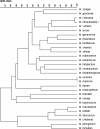Clinical manifestations, diagnosis, and treatment of Mycobacterium haemophilum infections
- PMID: 21976605
- PMCID: PMC3194825
- DOI: 10.1128/CMR.00020-11
Clinical manifestations, diagnosis, and treatment of Mycobacterium haemophilum infections
Abstract
Mycobacterium haemophilum is a slowly growing acid-fast bacillus (AFB) belonging to the group of nontuberculous mycobacteria (NTM) frequently found in environmental habitats, which can colonize and occasionally infect humans and animals. Several findings suggest that water reservoirs are a likely source of M. haemophilum infections. M. haemophilum causes mainly ulcerating skin infections and arthritis in persons who are severely immunocompromised. Disseminated and pulmonary infections occasionally occur. The second at-risk group is otherwise healthy children, who typically develop cervical and perihilar lymphadenitis. A full diagnostic regimen for the optimal detection of M. haemophilum includes acid-fast staining, culturing at two temperatures with iron-supplemented media, and molecular detection. The most preferable molecular assay is a real-time PCR targeting an M. haemophilum-specific internal transcribed spacer (ITS), but another approach is the application of a generic PCR for a mycobacterium-specific fragment with subsequent sequencing to identify M. haemophilum. No standard treatment guidelines are available, but published literature agrees that immunocompromised patients should be treated with multiple antibiotics, tailored to the disease presentation and underlying degree of immune suppression. The outcome of M. haemophilum cervicofacial lymphadenitis in immunocompetent patients favors surgical intervention rather than antibiotic treatment.
Figures




References
-
- Abbott M. R., Smith D. D. 1981. Mycobacterial infections in immunosuppressed patients. Med. J. Aust. 1:351–353 - PubMed
-
- Abell F., Harrison P. B., Seldon M. 1994. Mycobacterium haemophilum infection in an elderly patient. Aust. N. Z. J. Med. 24:404. - PubMed
-
- Armstrong K. L., James R. W., Dawson D. J., Francis P. W., Masters B. 1992. Mycobacterium haemophilum causing perihilar or cervical lymphadenitis in healthy children. J. Pediatr. 121:202–205 - PubMed
-
- Atlas R. M., Snyder J. W. 2006. Handbook of media for clinical microbiology, 2nd ed., p. 307 CRC Press, Boca Raton, FL
-
- Azov A. G., Koch J., Hamilton-Dutoit S. J. 2005. Improved diagnosis of mycobacterial infections in formalin-fixed and paraffin-embedded sections with nested polymerase chain reaction. APMIS 113:586–593 - PubMed
Publication types
MeSH terms
LinkOut - more resources
Full Text Sources
Medical

